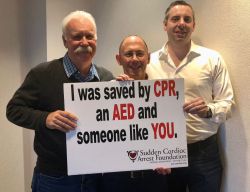
PITTSBURGH, PA--The Sudden Cardiac Arrest Foundation, a national 501(c)(3) community benefit organization, conducted its annual Board of Directors meeting on October 26-27th in Pittsburgh. Members came from around the country to discuss board development, review program highlights, and plan for the future. Four of the 10 board members are sudden cardiac arrest survivors and one is a mother who lost her son to SCA.
The Foundation's mission is "To raise awareness about sudden cardiac arrest and give 'ordinary' people the power to save a life." Since its inception 12 years ago, the organization has become the nation's preeminent information clearinghouse on sudden cardiac arrest and home of the SCA Network, an online community of survivors and their loved ones, loved ones of those lost to SCA, healthcare professionals and other advocates.
"We are honored to have dedicated board members with a wealth of clinical, development, financial, media and technology expertise--and personal experience related to sudden cardiac arrest," said Henry Jampel, MD, MHS, Johns Hopkins University professor, SCA survivor, and board chairman. "Our success is made possible by board and staff passion for the cause and generous support from foundations, corporate sponsors and a growing base of individual donors."
 Sudden cardiac arrest is a life-threatening emergency that occurs when the heart suddenly stops beating. It strikes people of all ages who may seem to be healthy, even children and teens. When SCA happens, the person collapses and doesn’t respond or breathe normally. They may gasp or shake as if having a seizure. SCA leads to death in minutes if the person does not get help right away. Survival depends on people nearby calling 911, starting CPR, and using an automated external defibrillator (AED), if available, as soon as possible.
Sudden cardiac arrest is a life-threatening emergency that occurs when the heart suddenly stops beating. It strikes people of all ages who may seem to be healthy, even children and teens. When SCA happens, the person collapses and doesn’t respond or breathe normally. They may gasp or shake as if having a seizure. SCA leads to death in minutes if the person does not get help right away. Survival depends on people nearby calling 911, starting CPR, and using an automated external defibrillator (AED), if available, as soon as possible.
SCA is the third leading cause of death in the U.S., affecting about 1,000 people outside hospitals each day. About 10 percent of victims survive, but survival rates can triple when people nearby start CPR immediately. Survival rates are even higher when bystanders use AEDs before EMS arrives at the scene.
SOURCE: Sudden Cardiac Arrest Foundation
